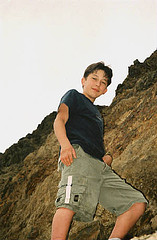Please, after reading below go to the IP online
link above. Do not let the words 'towel dispensers' or other terms through you off. This article directly confronts 'thrill
seeking behavior' and states what is needed for effective intervention. Please educate yourself and help save a child...Sarah
Strangulation in children and preadolescents usually results from unsafe play.
1 We found no previous reports of death by
hanging from cloth towels in dispensers. There were reported
cases
of children dying after hanging from window cords,
2 drawstrings
on clothing,
3 and a necklace.
4 Digeronimo
et al described three
cases of near-hanging in 1994, two of which resulted from unsafe
play.
5 We add to this literature five cases, one near-hanging
and four deaths, all likely the result of ill considered
thrill
seeking or risk taking behaviour.
Partial asphyxiation by hanging is a recognized thrill seeking behavior among youths. An altered level
of consciousness results from pressure altering cerebral venous and arterial blood flow, and
an associated rise in carbon dioxide tension. The resulting sensation is perceived as pleasurable and promotes
the (thrill seeking) behavior. In older male adolescents, autoerotic behavior involving partial
strangulation is recognized to occur, usually as a solitary act, and may be mistaken for attempted suicide.1
Two of our five cases were attributed to playing a "choking/blackout game" at school and this was a
possible cause in all five cases. Although suicide cannot be completely ruled out, all deaths were
due to strangulation from hanging in boys 7 to 12 years old. Suicides before the age of 15 have always
been rare.6 However, recent data indicate a doubling in the suicide rate among children 10 to 14 years between
1980 and 1992.7
LIMITATIONS
The main limitation in this study is its retrospective nature and focus on mortality. Our
inability to study morbidity resulted from information not being retrievable from other intensive care
units on any children who survived after near-strangulation. For reasons of confidentiality, such information is
not made available to external inquiry.
Implications for prevention
In making recommendations for injury prevention, it is critical to make use of epidemiological
data. Addressing preadolescent injury prevention through the schools may be an effective approach because
schools are an important site of unintentional injury and violence (10% to 25% of all injuries to youths). Because
they are also places of learning, schools can promote acquisition of lifelong attitudes to risk taking behavior
relevant to injury prevention.8 Using peer counselors in the injury prevention education process may be an effective means of generating
lifelong changes in risk taking behavior.9 Physicians, particularly those in emergency rooms, can contribute significantly to the health
of school children if they are involved in development and organization of systems for prevention of injury.10 However, neither schools nor health care providers alone can influence the issue of preadolescent
injury sufficiently to reduce an individual's risk to an acceptable level. To do this, an integrated process
of educational, legislative, and environmental approaches is necessary.10
http://ip.bmjjournals.com/cgi/content/full/7/3/231

